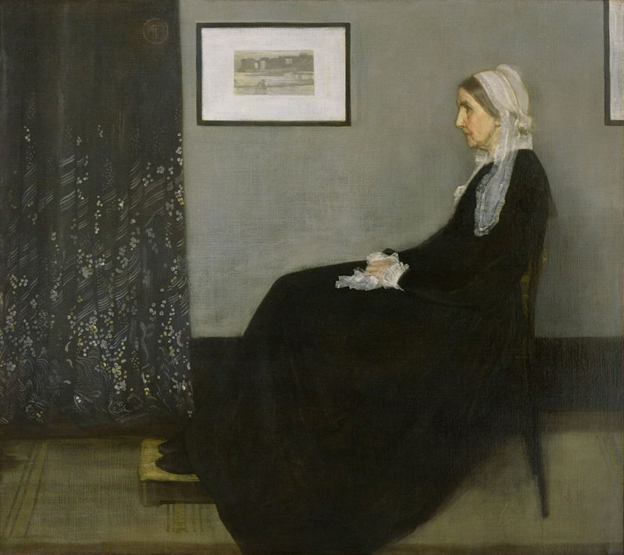Whistler's most famous painting, Arrangement in Grey and Black No. 1 (1871), commonly known as Whistler's Mother, is a revered portrait of motherhood. Several unverifiable stories stated that Anna Whistler acted as a replacement for another model who could not make the appointment.
Whistler originally envisioned painting the model standing up. However, his mother was too uncomfortable to pose standing for an extended period. The masterpiece was completed in 1871.
Arrangement In Grey and Black No. 1 "Whistler’s Mother"
Arrangement in Grey and Black No. 1, best known as "Whistler's Mother" is a painting in oils on canvas created by James Abbott McNeill Whistler in 1871. The subject of the painting is Whistler's mother, Anna McNeill Whistler. The painting is 56.81 by 63.94 inches (1,443 mm × 1,624 mm). It has been variously described as a Victorian Mona Lisa.
Arrangement in Grey and Black No. 1 artwork, which was purchased by the French government in 1891, is today one of the most well-known works by an American artist outside of the United States. The current owner of this oil on canvas piece is the Musée d'Orsay in Paris.
Whistler made this painting after returning from Paris, where he studied traditional art techniques at the Ecole Imperiale. Whistler depicts his mother as a rock-solid fortress, though this artwork was painted at a period when three of Anna McNeill Whisler's sons had been killed in the civil war. As a widow in bad health, she decided to travel to London to be with her son.
Whisler's mother is looking forward quietly, probably immersed in the sad contemplation of her life and the chaos all around her. She is dressed in typical black mourning clothes, with a white coif and white lace trim, indicating that she has been a widow for some time.
Whisler raised his mother's feet off the chilly ground on a stool and positioned her against a drawn curtain with one of his framed etchings on the wall. The artist's structure subtly depicts the artist's relationship with his mother.
Whistler insists that his mother's presence in the artwork has no symbolic significance. However, it appears like he subconsciously expressed a lot of his mother's struggles in the painting. Both literally and symbolically. His assessment of her personality is readily understandable and resonates with us.

James Abbot McNeill Whistler
James Abbott McNeill Whistler (July 10, 1834 – July 17, 1903) was an American painter active during the American Gilded Age and based primarily in the United Kingdom. He was a leading proponent of the credo "art for art's sake" and entitled many of his paintings "arrangements", "harmonies", and "nocturnes", emphasizing the primacy of tonal harmony.
Whistler's art is marked by a subtle delicacy just like the signature for his paintings which took the shape of a stylized butterfly possessing a long stinger for a tail. Whistler arrived in Paris in 1855, in a studio in the Latin Quarter, Whistler quickly adopted the life of a bohemian artist.
Whistler studied traditional art methods for a short time at the Ecole Impériale and the atelier of Marc Charles Gabriel Gleyre. Two years after enrolling in Charles Gleyre's studio at the Ecole des Beaux-Arts, he formed a collaboration with Alphonse Legros and Fantin-Latour to ensure wider distribution of his paintings.
To publicly prove his membership in the Parisian avant-garde genre, The French artist Henri Fantin-Latour (14 January 1836 – 25 August 1904) put Whistler in the center of his image Homage to Delacroix among Manet and Baudelaire. Whistler completed his first piece of art, Symphony in White, No. 1: The White Girl, at the age of 27.
Whistler, American Gilded Age Artist.
The Gilded Age artists were drawn to detail, well-finished surfaces, silky brushstrokes, soft light transitions, aesthetic compositions, and realistic color tones. Whistler's palette is a striking example of the Gilded Age painting style.
A subtle, sober color palette complemented by elegance. Even if a hard grey wall obscures the majority of the composition, the tenderness of his strokes cannot be overlooked.
Whistler's composition, in stark contrast to Impressionists, utilizes thin paints. The procedure is very slow, but as we can see, it is well worth the wait. Smooth, continuous strokes improve the painting's tonal balance and harmony.
Whistler masterfully balances a strong geometric structure and realism. In this painting, Whistler was able to properly portray his approach to tonal composition and harmony.
At first sight, the Arrangement in Grey and Black No. 1 appears straightforward. On closer inspection, the artwork does, however, represent a balance between the different shapes in the scene.
Whistler was able to use the correct rectangular shape for the floor, draperies, and wall painting. This made his mother's face, clothes, and chair more visible and stable.
Arrangement In Grey And Black No. 1 effectively establishes a balance between fragility, and strength, as well as delicacy and aggression.

Comments